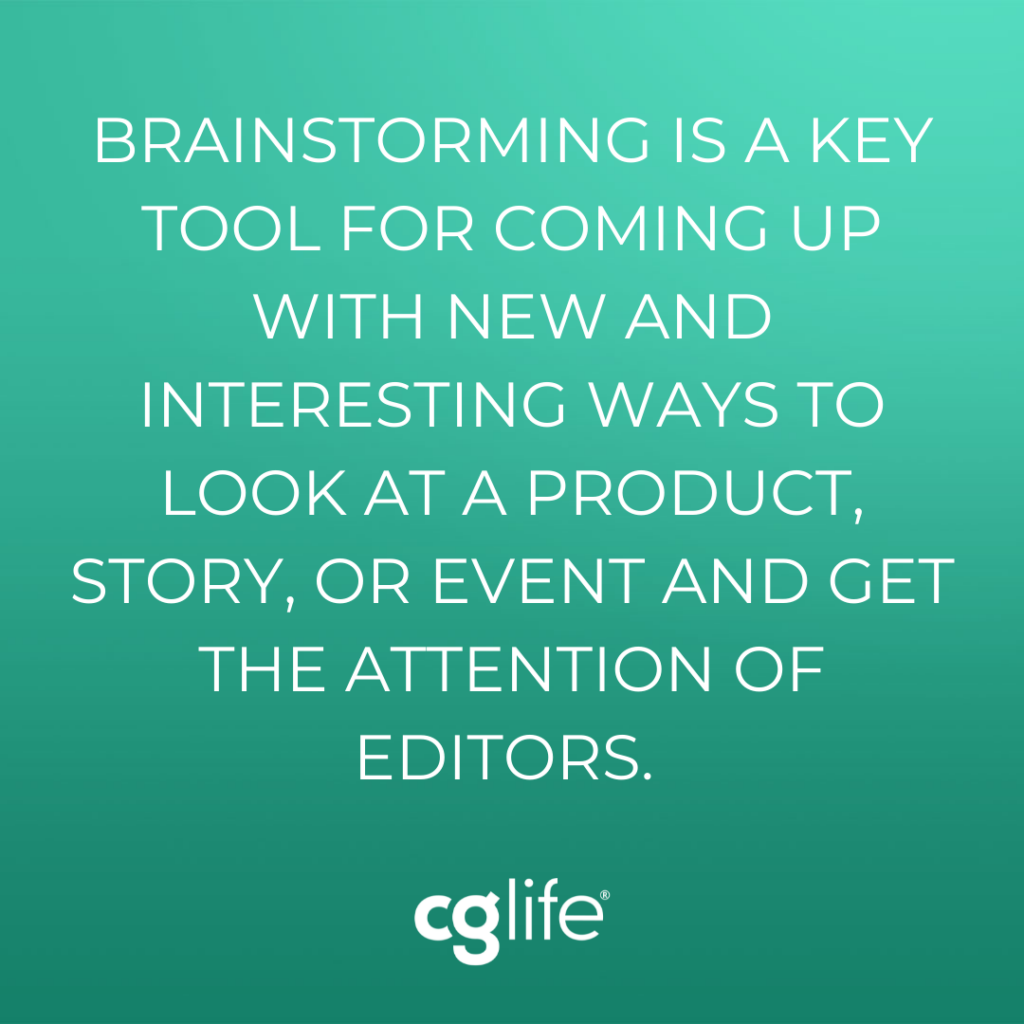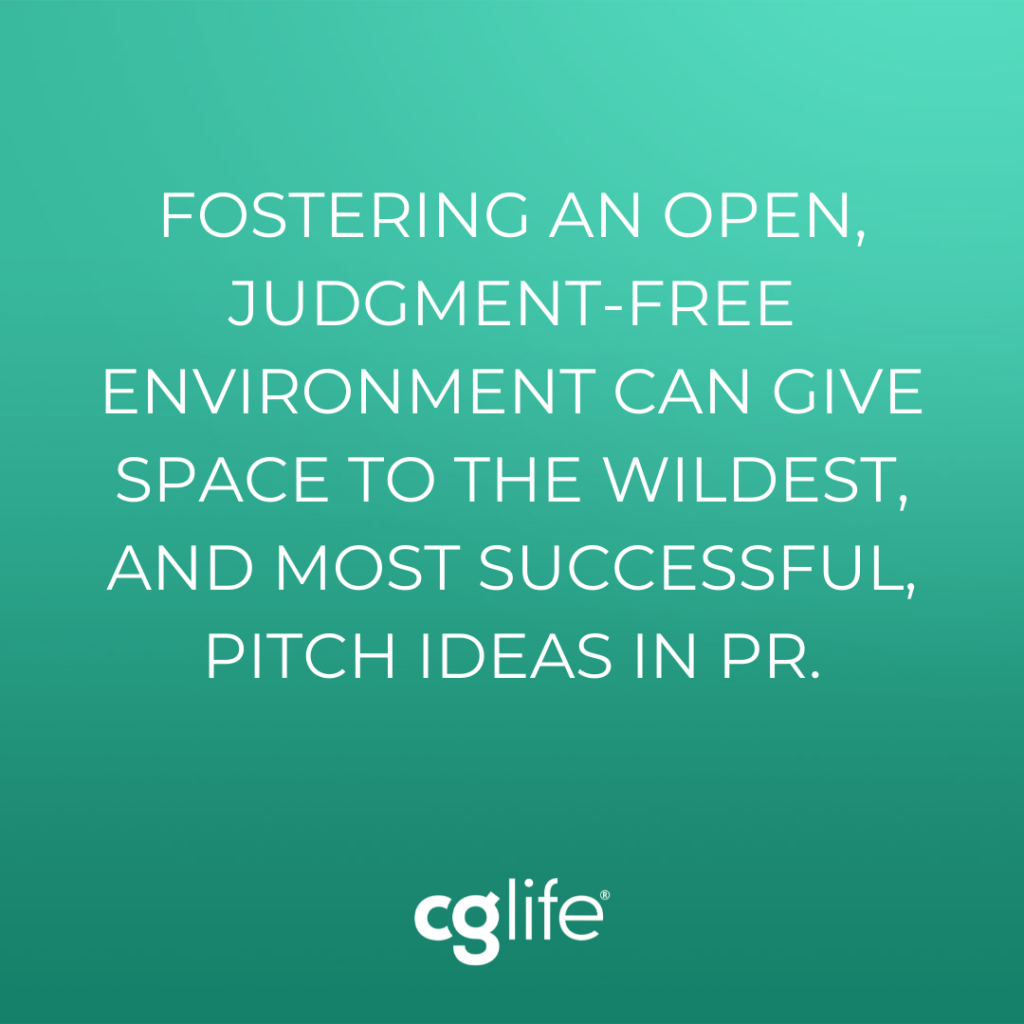Much of public relations is about finding newsworthy angles, new perspectives, and fresh ideas to generate results for clients. Brainstorming is a key tool for coming up with new and interesting ways to look at a product, story, or event and get the attention of editors. But how can we approach a brainstorming session to get the most out of the process? As good science writers should, let’s turn to research.
Individual or Group Brainstorming?
Researchers have been exploring the science of brainstorming since Alex Osborn coined the term in the early days of advertising agencies. The theory that group brainstorming sessions are more productive than individual brainstorming was first put to the test at Yale University in 1958. Surprisingly, the study found that individuals came up with more and better ideas than groups.
Why was this the case? Brainstorming session analysis revealed social dynamics in group discussions that can inhibit idea generation. First, people often consciously or subconsciously self-censor to avoid sharing more outlandish ideas that could draw judgment from the group. Humans are programmed to prioritize staying in good standing with a group, meaning that some of the most creative ideas never come to light. The loudest and most confident speakers also dominate the conversation, discouraging more introverted group members from contributing. Additionally, when groups start the discussion with one idea, that idea can influence the rest of the session before other unrelated ideas come to light.

When people are not faced with these social pressures, even the most introverted person can contribute ideas, and everyone can share more daring ideas. However, there are other answers than individual brainstorming. Groups can structure brainstorming discussions to mitigate these social pressures and overcome mental blocks to creativity.
Searching for the Key to Successful Group Brainstorming
If the problem with group brainstorming is self-censoring to avoid negative reactions from peers, how do we remove these social barriers?
A study by Leigh Thompson at Northwestern University’s Kellogg School of Management surveyed groups of participants tasked with thinking of as many uses as possible for common objects like paper clips. Some groups started by sharing a personal accomplishment, and others were asked to kick off with an embarrassing story about themselves. In the end, Thompson found that the discussion groups that shared self-deprecating stories generated 26% more ideas than the others. We don’t know exactly why this works, but we can theorize. Sharing these embarrassing moments may break down the fear of judgment from other group members and encourage more creative brainstorming.
Other researchers at the University of Pittsburgh set out to understand how breakthrough ideas come to be. Joel Chan and Cristian Schunn analyzed transcripts from a professional design team’s brainstorming sessions. New ideas, they found, did not come from massive cognitive leaps but rather a series of small steps. Expecting a “eureka moment,” they said, is ineffective. They determined that for successful idea generation, groups should not pressure themselves to come up with big ideas but rather get the ball rolling incrementally.
Additionally, Chan and Schunn observed that in these conversations, new analogies surfaced every five minutes. Analogies come naturally to humans–to survive, brains subconsciously compare what’s happening now to past experiences. This process helps us understand the world and find solutions to new problems. In brainstorming sessions, making these analogies can break through mental blocks. For example, the study participants compared a printer door to a video tape flap, a garage door, and a roller door—these new concepts brought forth various engineering ideas.
Another way to relieve the pressure of brainstorming is to stop searching for answers and look for questions instead. After trying it with his students, Hal Gregersen wrote a book about this tactic. He found that asking participants to offer questions about a topic for four minutes brought about many new pathways to look at the topic where asking for new ideas had failed. Starting with questions can get the creativity flowing and take brainstorming in an unanticipated direction.

Brainstorming Strategies for Your Next Session
Whether you are brainstorming alone or with your team, consider these tools for your next discussion.
- Freewriting. Freewriting is one way to brainstorm individually on a topic. Write down whatever comes to your mind without judgment. Try setting a time limit or doing it with your eyes shut to encourage freedom of thought. Keep writing even if you think it’s useless. Another study from Kellogg suggests that when we think we’re finished brainstorming, we should persist for another 10 minutes anyway.
- Mind mapping. Write your main topic in the center of a page. Then, quickly write down any related terms that come to mind around the main topic. Draw circles around related terms and connect them with a line to explore new connections and similarities between ideas.
- Doodling. A large part of your brain is dedicated to visual processing. Sketching whatever comes to mind about a topic can get new parts of your brain involved in the brainstorming process. Pay attention to any new thoughts that might emerge and write them down.
- Round robin. In a group, have each participant write down ideas for a set amount of time. Then, go around the circle and have each person offer an idea. This helps avoid being influenced by the ideas first brought up in the meeting.
- 6-3-5. In a group of six, ask each to write three ideas on the topic. Then, pass the topics to the left, and have the next person build on them with one new idea. Repeat the process five times. This way, everyone contributes initial ideas and builds on each other before opening the floor to discussion.
- Scientific method. Try applying the scientific method to brainstorming. The scientific method can provide structure and clarity to your next brainstorming session. First, observe: what’s the problem we’re trying to solve? Next, set the question: what’s the goal? Generate hypotheses as a group, and explore and refine each idea. Then, split the group into teams to debate and disprove the hypotheses. Put the winning idea into practice, and analyze the results.
Creating the Best Environment for Your Brain
We’ve all experienced writer’s block, but giving our brains the tools to get unstuck and find creative solutions is essential. Collaboration can bring out our best, but only under the right conditions. Fostering an open, judgment-free environment can give space to the wildest and most successful pitch ideas in PR. Here at CG Life, we’ve got brainstorming down to a science. If you’re looking for new ideas to get your message out there, give us a shout!
